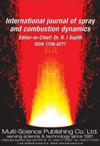居里夫人探戈项目在热声学和空气声学方面的进展
IF 2.1
4区 工程技术
Q3 ENGINEERING, MECHANICAL
International Journal of Spray and Combustion Dynamics
Pub Date : 2018-12-01
DOI:10.1177/1756827718808076
引用次数: 0
摘要
这期特刊精选了TANGO项目制作的研究论文。TANGO是一个由7个学术伙伴和5个工业伙伴组成的国际财团的初始培训网络(ITN)。TANGO是“带有孔板结构的绿色燃烧器中的热声和气动声非线性”的首字母缩略词。在该网络成立的4年间(2012-2016),共有15名青年研究人员获得了该网络的资助;他们中的大多数人都有三年的博士学位。关于TANGO的更多信息(如联盟成员,研究任务和出版物)可以在项目网站http://www.scm.keele.ac.uk/Tango/上找到,正如项目标题所示,热声学和空气声学是科学探索的主要领域。这些学科是理解热声不稳定性的基础。驱动热声不稳定的基本机制是热源(通常是火焰)释放的热量、容纳热源的腔体中的声场和空气动力学结构(如从孔板脱落的涡流,然后撞击火焰)之间的三向相互作用。这一基本机制与其他物理和化学过程一起发生,导致了一个复杂的相互作用网络,其中大多数是非线性的。解开这个网络的研究已经进行了几十年,但仍然有很多悬而未决的问题。出于环境原因,使燃烧器“绿色”非常重要,即开发具有低污染物排放水平的燃烧系统。这是通过稀薄预混燃烧实现的。不幸的是,这种形式的燃烧特别容易产生热声不稳定性。它们表现为强烈的压力振荡、过度的结构振动、疲劳,甚至对燃烧室硬件造成灾难性的破坏。在热声不稳定性被完全理解之前,它们是绿色燃烧系统发展的一个障碍。TANGO的目的是发展大量的新认识,以便预测在什么条件下会发生这种不稳定,达到什么幅度,以及最重要的是如何预防不稳定。这项研究是跨学科的,涉及数值、分析和实验方法。它可以大致分为两个部分:热声学和气动声学,尽管在这两个部分之间有相当大的相互作用。两篇综述论文,一篇关注热声学,另一篇关注空气声学,将出现在本期杂志的下一期。本期的论文经过了严格的审查。他们重点介绍了TANGO在一系列主题上的研究活动,包括本文章由计算机程序翻译,如有差异,请以英文原文为准。
Advances by the Marie Curie project TANGO in thermoacoustics and aeroacoustics
This special issue features a selection of research papers produced by the project TANGO – an initial training network (ITN) with an international consortium of seven academic and five industrial partners. TANGO is the acronym for ‘Thermoacoustic and Aeroacoustic Nonlinearities in Green combustors with Orifice structures’. During the four years of its lifetime (2012–2016), a total of 15 young researchers were funded by this network; the majority of them had three-year PhD positions. Further information about TANGO (such as the consortium members, research tasks and publications) can be found on the project website http://www.scm.keele.ac.uk/Tango/ As the title of the project suggests, thermoacoustics and aeroacoustics were the main areas of scientific enquiry. These disciplines are fundamental for the understanding of thermoacoustic instabilities. The basic mechanism driving a thermoacoustic instability is a three-way interaction between the heat release from a heat source (typically a flame), the acoustic field in the cavity that houses the heat source, and aerodynamic structures (such as vortices shed from an orifice and then impinging on the flame). This basic mechanism occurs in tandem with other physical and chemical processes, leading to a complex web of interactions, most of which are nonlinear. Research to unravel this web has been going on intensively for decades, but there are still a lot of open questions. For environmental reasons, it is important to make combustors ‘green’, i.e. to develop combustion systems that have low levels of pollutant emission. This is achieved by lean premixed combustion. Unfortunately, this form of combustion is particularly prone to thermoacoustic instabilities. They manifest themselves by intense pressure oscillations, excessive structural vibrations, fatigue and even catastrophic damage to combustor hardware. Until thermoacoustic instabilities are fully understood, they are an obstacle for the development of green combustion systems. The aim of TANGO was to develop a large amount of new understanding so as to predict under what conditions such instabilities occur, what amplitudes are reached, and – most importantly – how the instabilities can be prevented. The research was interdisciplinary and involved numerical, analytical and experimental approaches. It can be roughly divided into two parts: thermoacoustics and aeroacoustics, although there was considerable interaction across this divide. Two review papers, one focussing on thermoacoustics and the other one on aeroacoustics, will appear in a forthcoming issue of this journal. The papers in this issue have undergone a rigorous review process. They give highlights of TANGO’s research activities on a range of topics, including
求助全文
通过发布文献求助,成功后即可免费获取论文全文。
去求助
来源期刊

International Journal of Spray and Combustion Dynamics
THERMODYNAMICS-ENGINEERING, MECHANICAL
CiteScore
2.20
自引率
12.50%
发文量
21
审稿时长
>12 weeks
期刊介绍:
International Journal of Spray and Combustion Dynamics is a peer-reviewed open access journal on fundamental and applied research in combustion and spray dynamics. Fundamental topics include advances in understanding unsteady combustion, combustion instability and noise, flame-acoustic interaction and its active and passive control, duct acoustics...
 求助内容:
求助内容: 应助结果提醒方式:
应助结果提醒方式:


